Soil–Structure Interaction and Damping by the Soil—Effects of Foundation Groups, Foundation Flexibility, Soil Stiffness and Layers
Abstract
1. Introduction
2. Methods of Calculation
2.1. The Standard Symbols and Parameters
- displacements u;
- particle velocities v;
- forces F or P;
- dynamic stiffness K = F/u;
- dynamic compliance C = u/F;
- impedance F/v;
- admittance v/F;
- frequency f;
- circular frequency ω = 2πf;
- imaginary unit i or j.
- shear modulus G = 2, 4.5, 8, 13 × 107 N/m2;
- Poisson’s ratio ν = 0.33;
- mass density ρ = 2000 kg/m3;
- material damping D = 2.5%.
- shear wave velocity vs = 100, 150, 200, 300 m/s;
- compressional wave velocity vP = 2vS;
- wave impedance Z = √Gρ = G/vS = ρvS.
- elasticity modulus E = 3 × 1010 N/m2;
- mass density ρ = 2500 kg/m3.
- elasticity modulus E = 2.1 × 1011 N/m2,
- mass density ρ = 7800 kg/m3.
2.2. The Finite-Element Boundary-Element Method
3. Methods of Measurement and Evaluation
3.1. Material Damping from Attenuation with Distance
3.2. Modal Damping from the Approximation of Frequency Response Functions
4. Damping and Stiffness of Rigid Foundations on Homogeneous Soil
4.1. Damping and Stiffness of Rigid Footings
4.2. Vertical Damping and Stiffness of Group and Strip Foundations
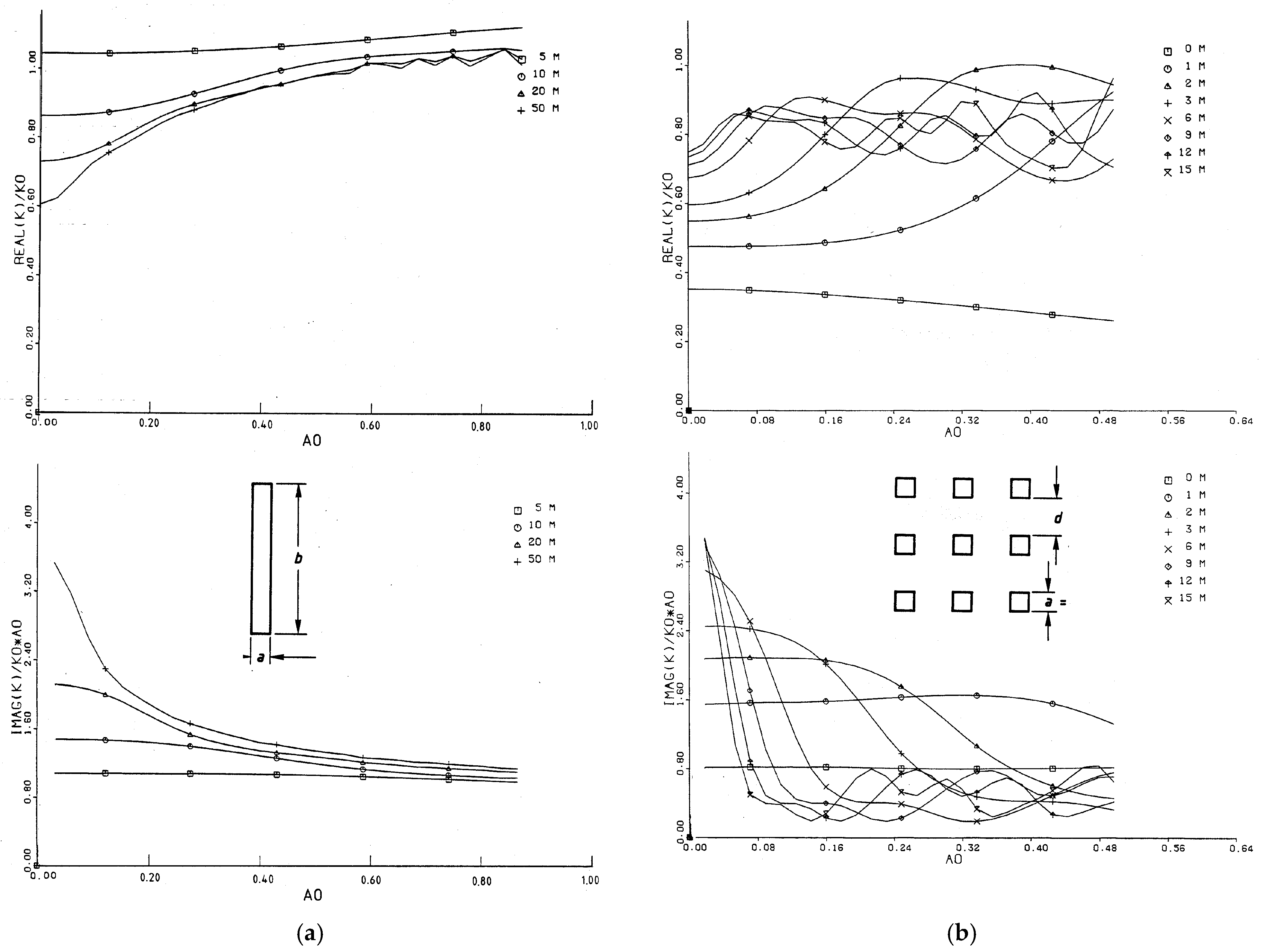
4.3. Building Foundations
5. Stiffness and Damping of Rigid Foundations on Layered Soil
6. Damping and Stiffness of Flexible Foundations
6.1. Damping and Stiffness of Railway Tracks
6.2. Vertical and Horizontal Damping and Stiffness of Piles
6.3. Dynamic Compliances of Beam and Plate Foundations
- –
- The influence of the structure is increasing with frequency;
- –
- The structure is dominating the behaviour at high frequencies;
- –
- The soil is dominating the behaviour at low frequencies;
- –
- The influence of the soil is decreasing with frequency;
- –
- The damping is decreasing with frequency and is not a viscous damper as for a rigid foundation.
7. Applications and Measurements
7.1. Response of a Foundation Block to Different Impact Excitations
7.2. Response of Buildings to Ground Vibration
7.3. Floor Resonances and Soil–Structure Interaction
7.4. Measured and Calculated Compliances of Different Railway Tracks
8. Conclusions
- The basic model of a rigid disc or square foundation on a homogeneous soil has an almost constant stiffness and an almost constant damping which is due to the radiation into the soil and which behaves like a viscous damper.
- The translational stiffness is proportional to the stiffness of the soil and to the radius of the foundation, and the damping is proportional to the wave impedance and the area of the foundation.
- For the rotational-degrees-of-freedom rocking and torsion, the stiffness has a stronger dependency on the radius k~r3 and the damping c~r4. The low-frequency damping of the rotations is zero.
- The damping is dominating the dynamic stiffness or compliance from a certain frequency on which it is lower for softer soils.
- Groups of foundations approach limit values with some oscillations which are proportional to the total area of the foundation. At low frequencies, foundation groups have a lower stiffness and a much higher damping c~k2.
- Layered soils have a lower radiation damping up to the horizontal resp. vertical layer frequency.
- The strong effect of a thin top layer has been found for residential buildings in theory and measurement.
- Flexible foundations like beams, plates, piles, and tracks have a smaller damping than rigid foundations of the same size.
- The damping of flexible foundations is decreasing with frequency, with the strongest with c~1/√f for the plate foundation. This damping is not well-represented by a viscous damper.
- The properties of the structure (the bending stiffness B for the plate) replaces a part of the soil stiffness in the soil–structure interaction results.
- Therefore, the static stiffness of a flexible foundation is less than proportional to the soil stiffness as k~Gp B1−p with 1−p < p < 1, but the soil is still dominant.
- At higher frequencies, the damping becomes dominant, and the mass of the structure is dominant at the highest frequencies.
- The high-frequency laws for flexible foundations are different from the laws for rigid foundations. The phase of the dynamic stiffness (the phase delay of the dynamic compliance) is not 90° as for the dominating damping of a rigid foundation and it does not approach 180° when the mass is dominating. The phase delay of the dynamic compliance and, therefore, the damping of flexible foundations is smaller, for example, 45° at mid and 90° at high frequencies for a flexible plate.
Funding
Data Availability Statement
Conflicts of Interest
References
- Kausel, E. Early history of soil-structure interaction. Soil Dyn. Earthq. Eng. 2010, 30, 822–832. [Google Scholar] [CrossRef]
- Roesset, J. Soil structure interaction: The early stages. Appl. Sci. Eng. 2013, 16, 1–8. [Google Scholar]
- Richard, F.; Hall, J.; Woods, R. Vibrations of Soils and Foundations; Prentice-Hall: Englewood Cliffs, NJ, USA, 1970. [Google Scholar]
- Luco, J. Impedance functions for a rigid foundation on a layered medium. Nucl. Eng. Des. 1974, 31, 204–217. [Google Scholar] [CrossRef]
- Gazetas, G. Analysis of machine foundation vibrations: State of the art. Soil Dyn. Earthq. Eng. 1983, 2, 2–42. [Google Scholar] [CrossRef]
- Wolf, J. Dynamic Soil-Structure Interaction; Prentice-Hall: Englewood Cliffs, NJ, USA, 1985. [Google Scholar]
- Todorovska, M.; Trifunac, M. The system damping and system frequency and the system response peak amplitudes during in-plane building-soil interaction. Earthq. Eng. Struct. Dyn. 1992, 21, 127–144. [Google Scholar] [CrossRef]
- Auersch, L. Building response due to ground vibration—Simple prediction model based on experience with detailed models and measurements. Int. J. Acoust. Vib. 2010, 15, 101–112. [Google Scholar] [CrossRef]
- Cruz, C.; Miranda, E. Evaluation of soil-structure interaction effects on the damping ratios of buildings subjected to earthquakes. Soil Dyn. Earthq. Eng. 2017, 100, 183–195. [Google Scholar] [CrossRef]
- Domenech, A.; Martinez-Rodrigo, M.; Romero, A.; Galvin, P. Soil-structure interaction effects on the resonant response of railway bridges under high-speed traffic. Int. J. Rail Transp. 2015, 3, 201–214. [Google Scholar] [CrossRef]
- Heiland, T.; Aji, H.; Wuttke, F.; Stempniewski, L.; Stark, A. Influence of soil-structure interaction on the dynamic characteristics of railroad frame bridges. Soil Dyn. Earthq. Eng. 2023, 167, 107800. [Google Scholar] [CrossRef]
- Shadlou, M.; Bhattacharya, S. Dynamic stiffness of monopiles supporting offshore wind turbine generators. Soil Dyn. Earthq. Eng. 2016, 88, 15–32. [Google Scholar] [CrossRef]
- Alamo, G.; Aznarez, J.; Padron, L.; Martinez-Castro, A.; Gallego, R.; Maeso, O. Dynamic soil-structure interaction in offshore wind turbines on monopiles in layered seabed based on real data. Ocean Eng. 2018, 156, 14–24. [Google Scholar] [CrossRef]
- Auersch, L. Compliance and damping of piles for wind tower foundation in nonhomogeneous soils by the finite-element boundary-element method. Soil Dyn. Earthq. Eng. 2019, 120, 228–244. [Google Scholar] [CrossRef]
- Ju, S. Finite element analysis of structure borne vibration from high-speed train. Soil Dyn. Earthq. Eng. 2007, 27, 259–273. [Google Scholar] [CrossRef]
- Takemiya, H.; Bian, X. Substructure simulation of inhomogeneous track and layered ground dynamic interaction under train passage. J. Eng. Mech. ASCE 2005, 131, 699–711. [Google Scholar] [CrossRef]
- Hussein, M.; Hunt, H.; Kuo, K.; Alves Costa, P.; Barbosa, J. The use of sub-modelling technique to calculate vibration in buildings from underground railways. J. Rail Rapid Transit 2015, 229, 303–314. [Google Scholar] [CrossRef]
- Jean, P.; Guigou, C.; Villot, M. A 2.5D BEM model for ground structure interaction. Build. Acoust. 2004, 11, 157–173. [Google Scholar] [CrossRef]
- Aji, H.; Wuttke, F.; Dineva, P. 3D structure-soil-structure interaction in an arbitrary layered half-space. Soil Dyn. Earthq. Eng. 2022, 159, 107352. [Google Scholar] [CrossRef]
- Colaco, A.; Alves Costa, P.; Amado-Mendes, P.; Calcada, R. Vibrations induced by railway traffic in buildings: Experimental validation of a sub-structuring methodology based on 2.5D FEM-MFS and 3D FEM. Eng. Struct. 2021, 240, 112381. [Google Scholar] [CrossRef]
- Liravi, H.; Arcos, R.; Clot, A.; Conto, K.; Romeu, J. A 2.5D coupled FEM-SBM methodology for soils-structure dynamic interaction problems. Eng. Struct. 2022, 250, 113371. [Google Scholar] [CrossRef]
- Auersch, L. Wechselwirkung Starrer und Flexibler Strukturen mit dem Baugrund Insbesondere bei Anregung durch Bodenerschütterungen. Ph.D. Thesis, BAM Berlin, Ruhr-University Bochum, Berlin, Bochum, Germany, 1988. [Google Scholar]
- Aubry, D. Sur une approche intégrée de l’interaction sismique sol-structure. Rev. Française De Géotechnique 1986, 38, 5–24. [Google Scholar] [CrossRef][Green Version]
- Gaitanaros, A.; Karabalis, D. Dynamic analysis of 3-D flexible embedded foundations by a frequency domain BEM-FEM. Earthq. Eng. Struct. Dyn. 1988, 16, 653–674. [Google Scholar] [CrossRef]
- Dangla, P. Couplage Éléments Finis-Équations Intégrales en Élastodynamique et Interaction Sol-Structure. Ph.D. Thesis, ENPC Paris, Paris, France, 1989. [Google Scholar]
- Clouteau, D.; Cottereau, R.; Lombaert, G. Dynamics of structures coupled with elastic media—A review of numerical models and methods. J. Sound Vib. 2013, 332, 2415–2436. [Google Scholar] [CrossRef]
- Auersch, L. Zur Dynamik einer unendlichen Platte auf dem Halbraum—Fundamentnachgiebigkeit und Wellenfeld bei harmonischer Punktlast. Arch. Appl. Mech. 1994, 64, 346–356. [Google Scholar] [CrossRef]
- Auersch, L. Dynamic interaction of various beams with the underlying soil—Finite and infinite, half-space and Winkler models. Eur. J. Mech. A/Solids 2008, 27, 933–958. [Google Scholar] [CrossRef]
- Rücker, W.; Auersch, L.; Baeßler, M.; Knothe, K.; Wu, Y.; Popp, K.; Kruse, H.; Savidis, S.; Hirschauer, R.; Bode, C.; et al. A comparative study of results from numerical track-subsoil calculations. In Lecture Notes in Applied Mechanics “System Dynamics and Long-Term Behaviour of Railway Vehicles, Track and Subgrade”; Popp, K., Schiehlen, W., Eds.; Springer: Berlin, Germany, 2003; pp. 471–488. [Google Scholar]
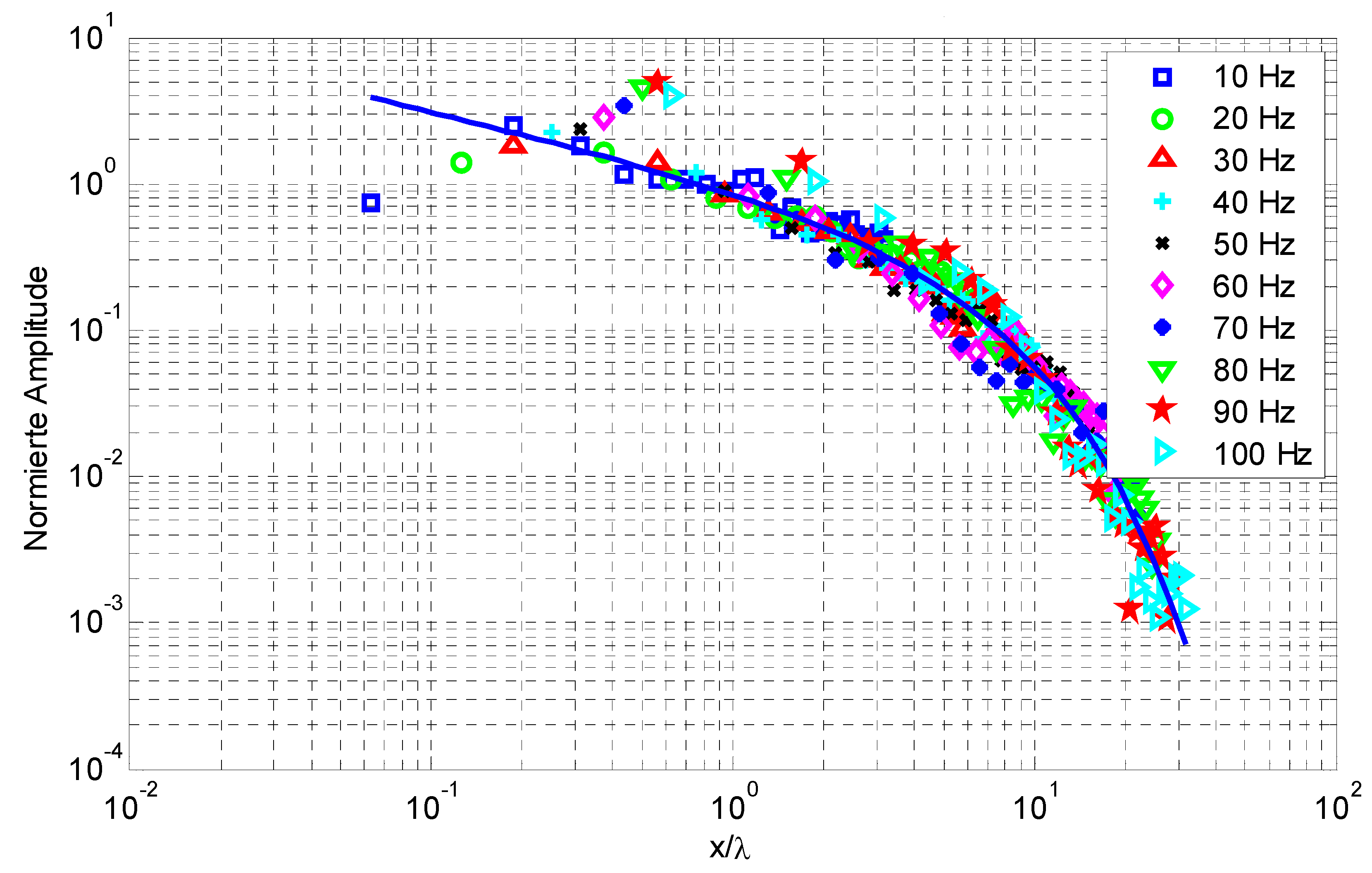
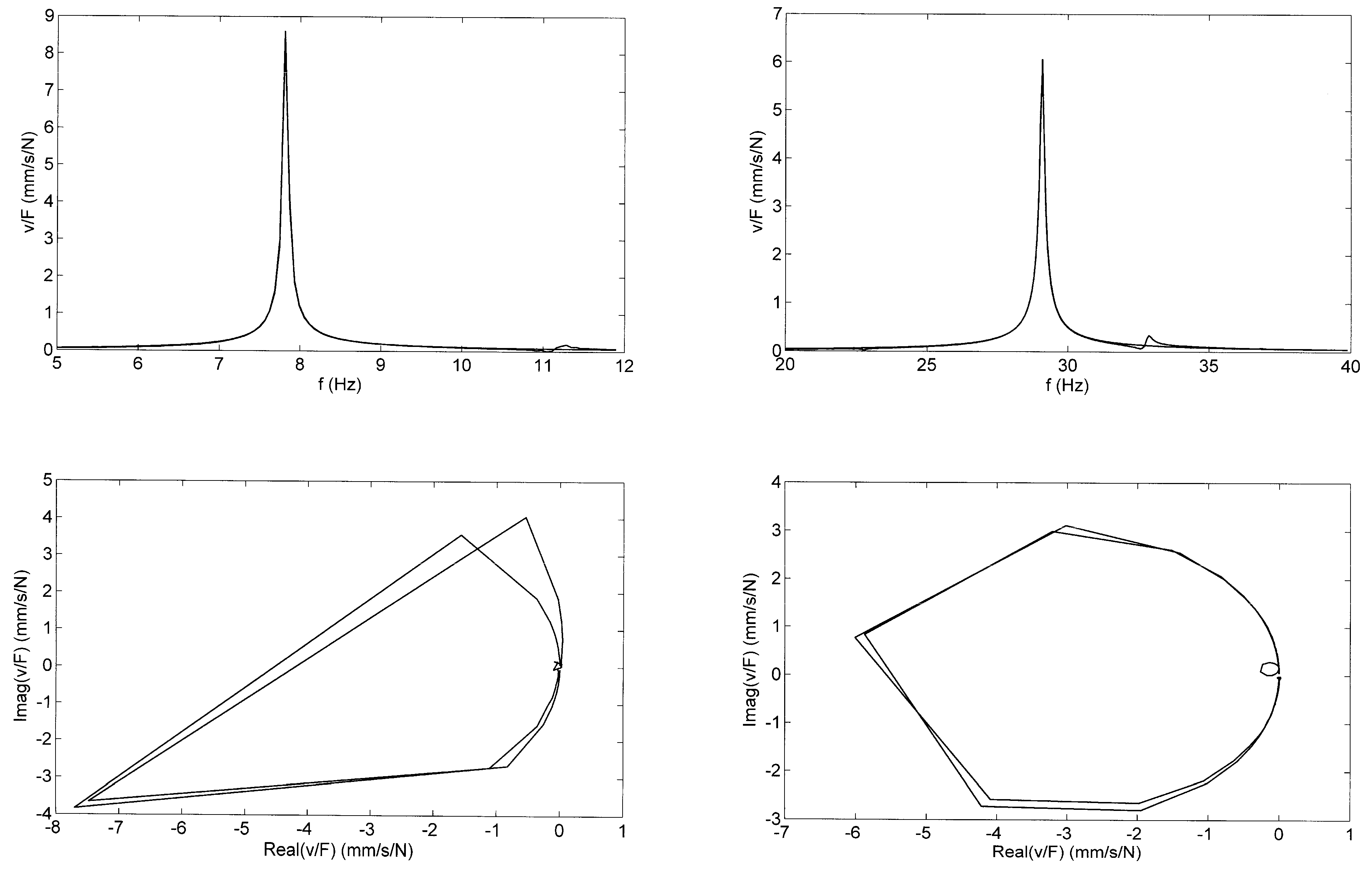

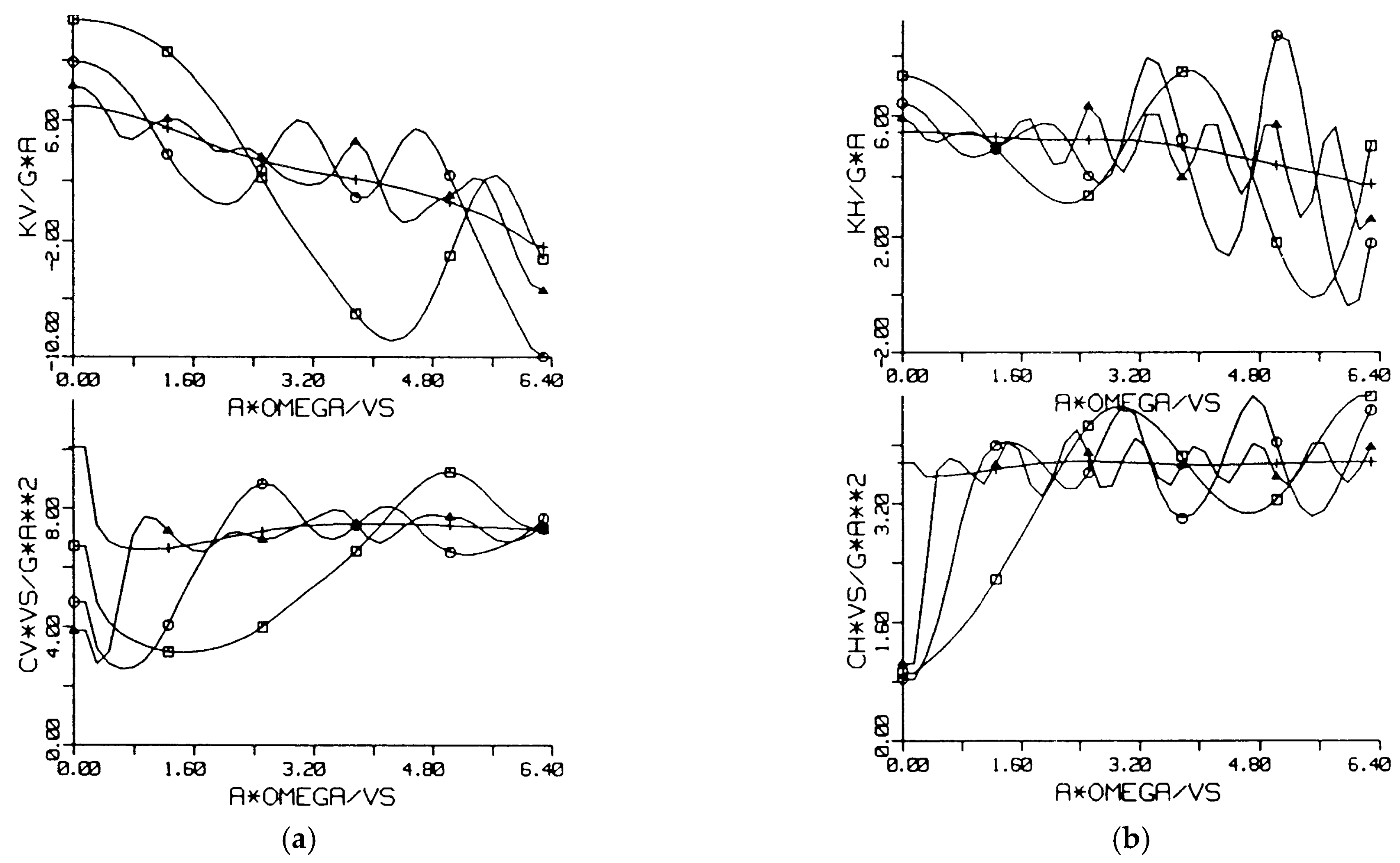
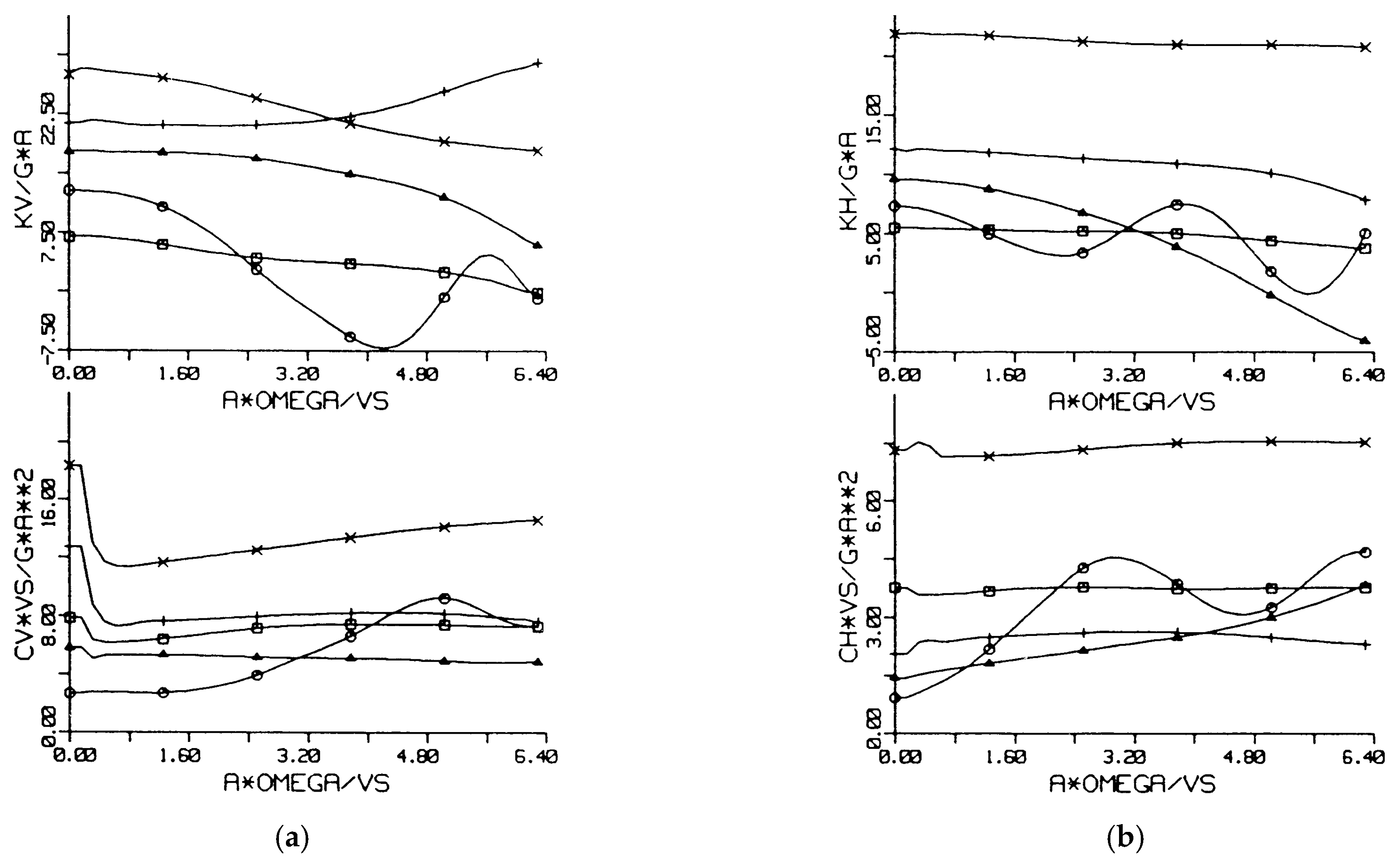
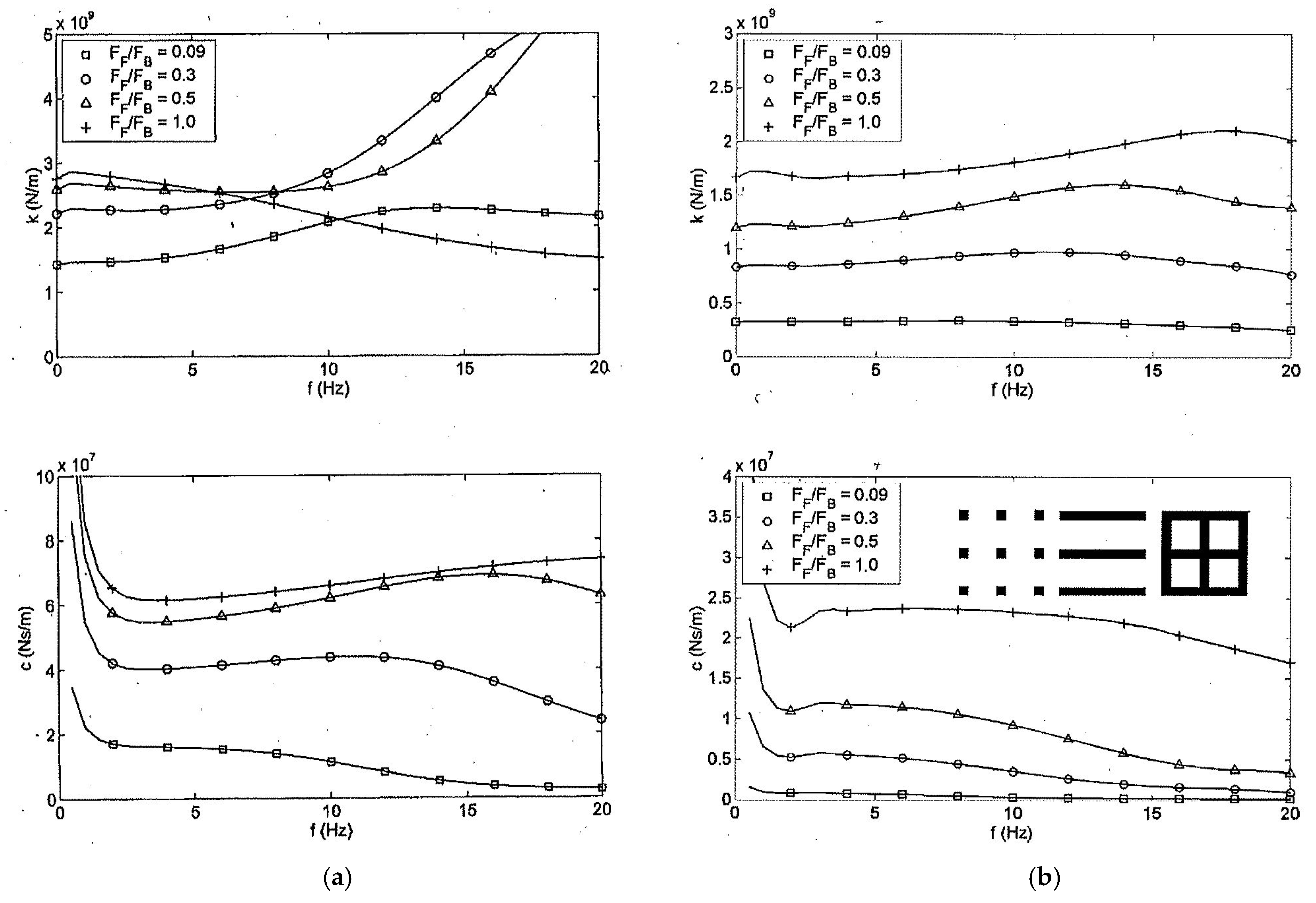
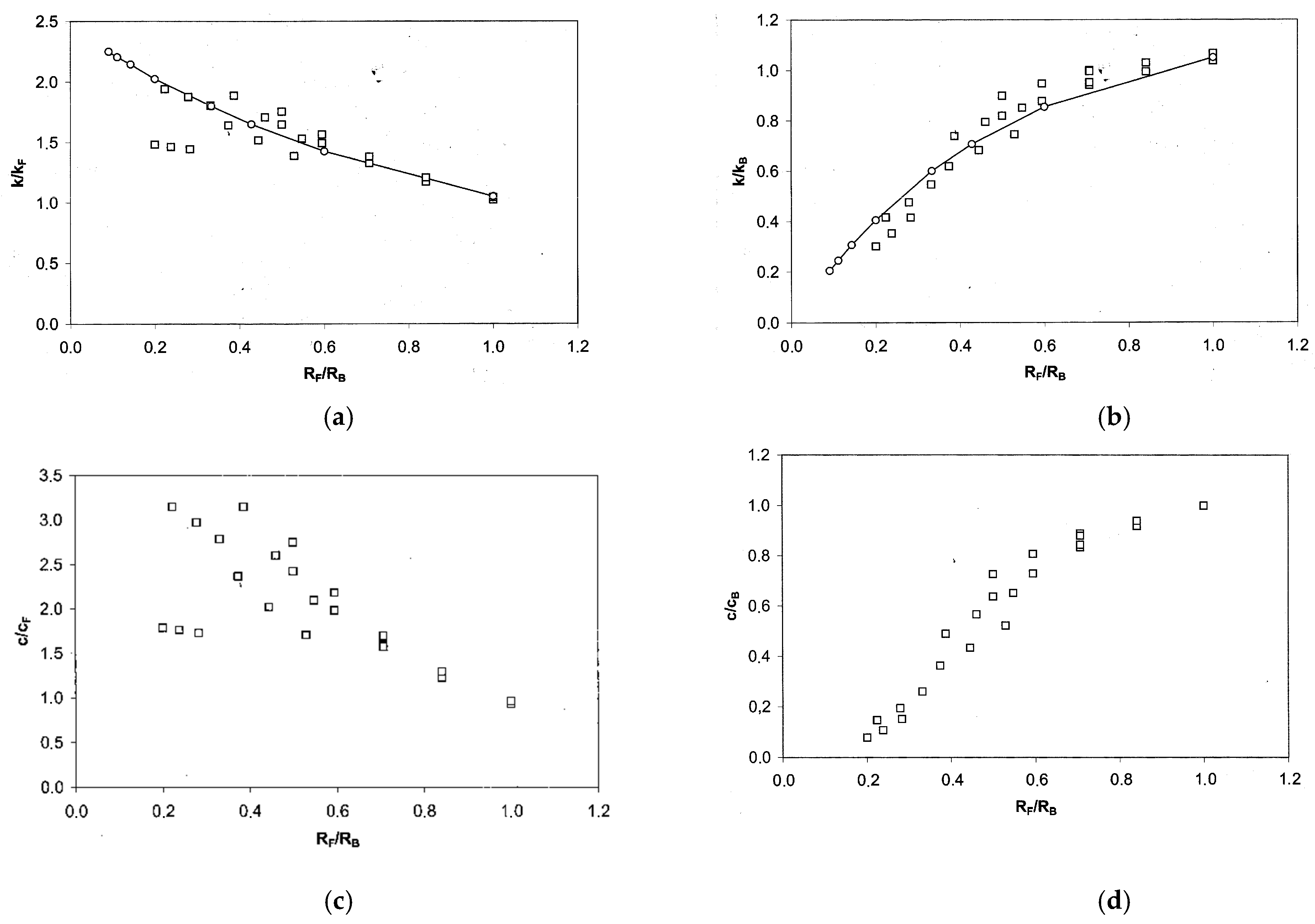

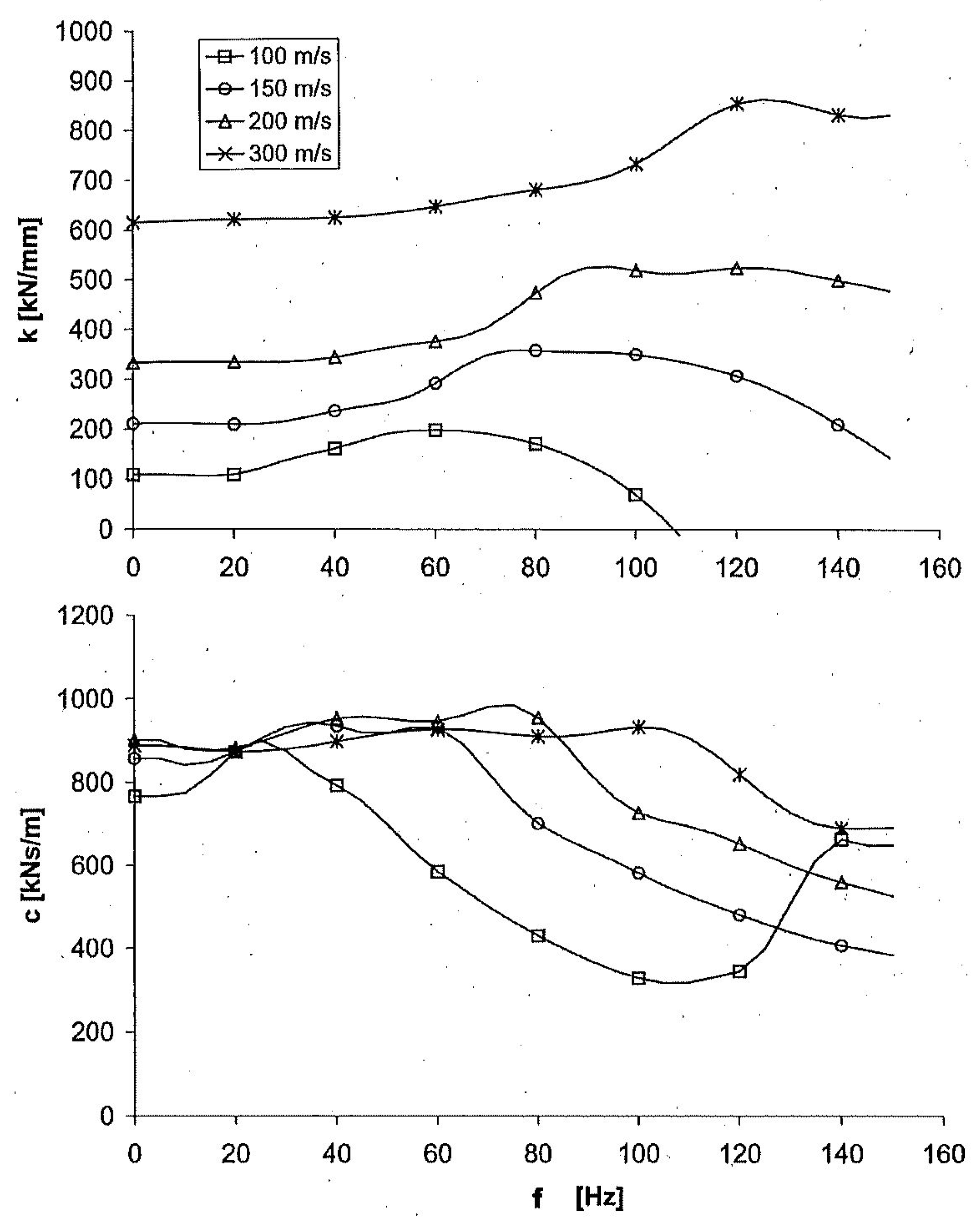


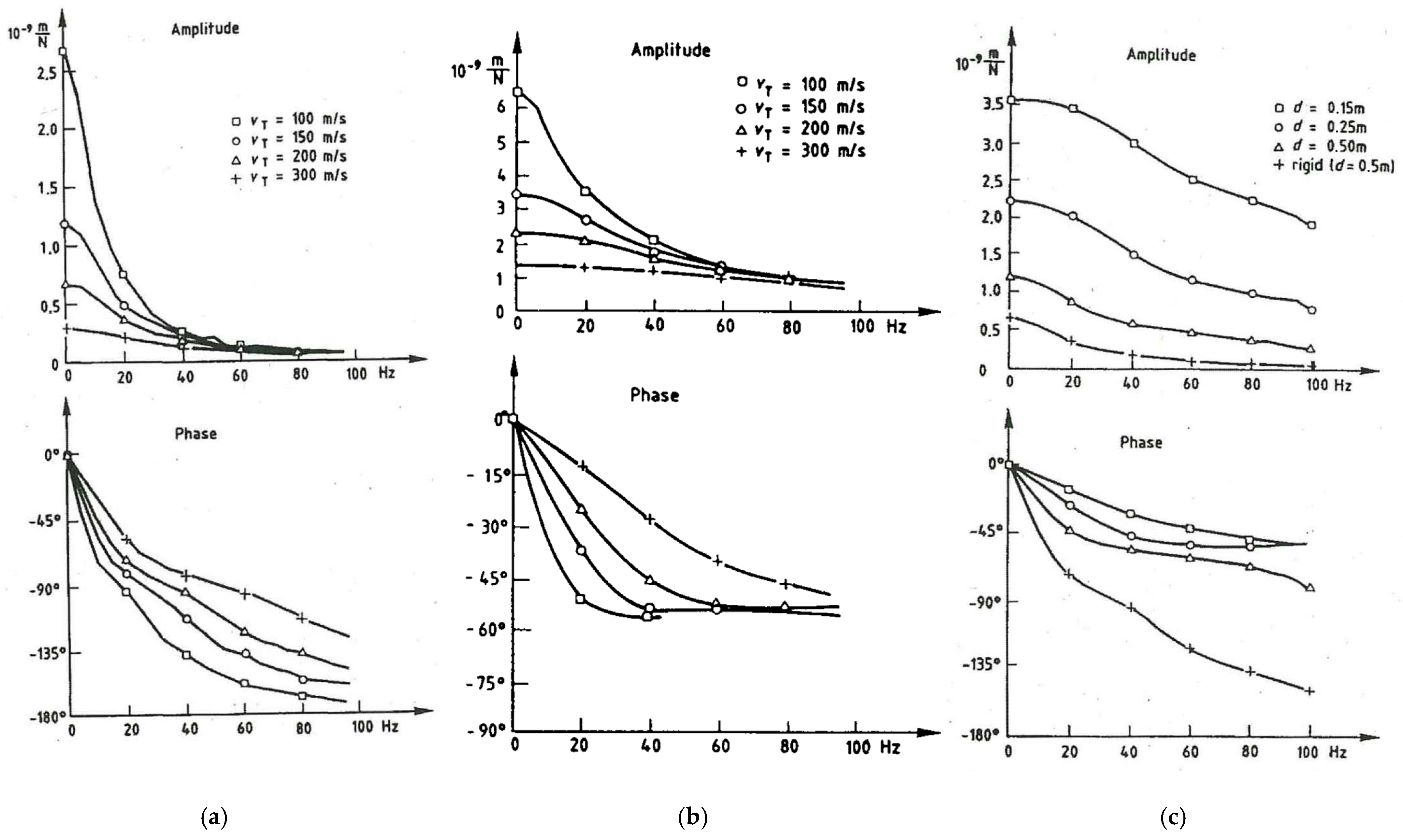
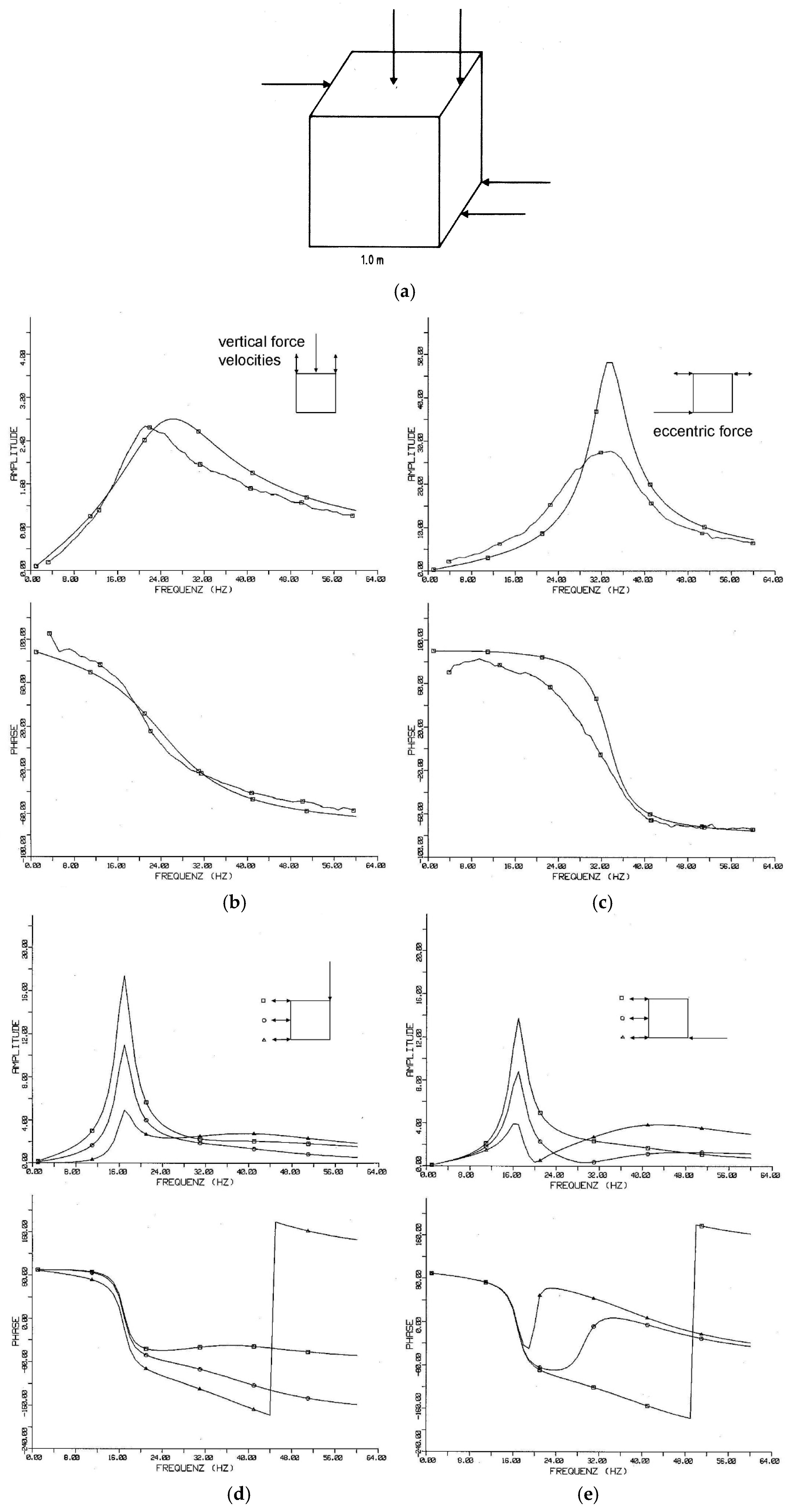
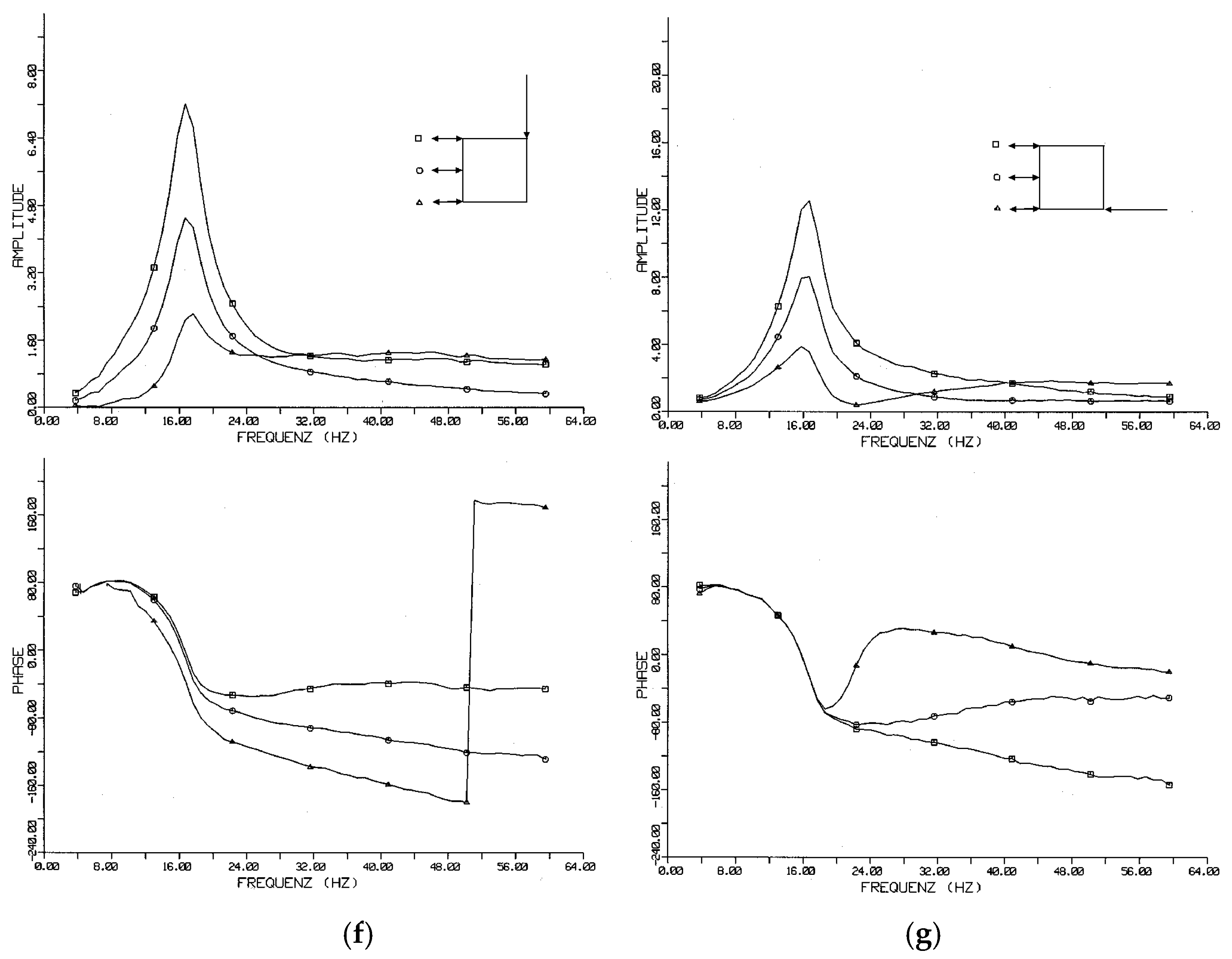
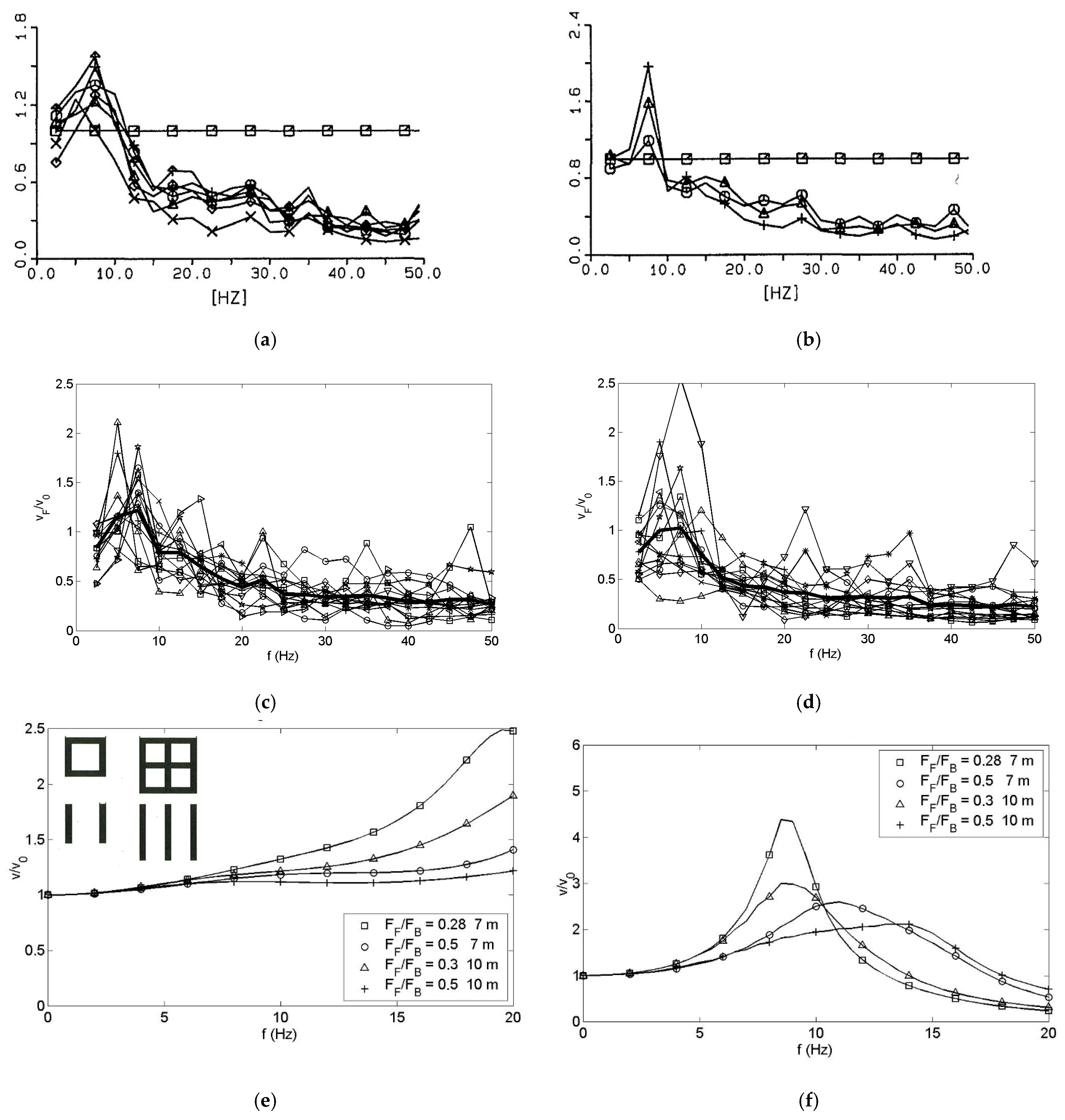
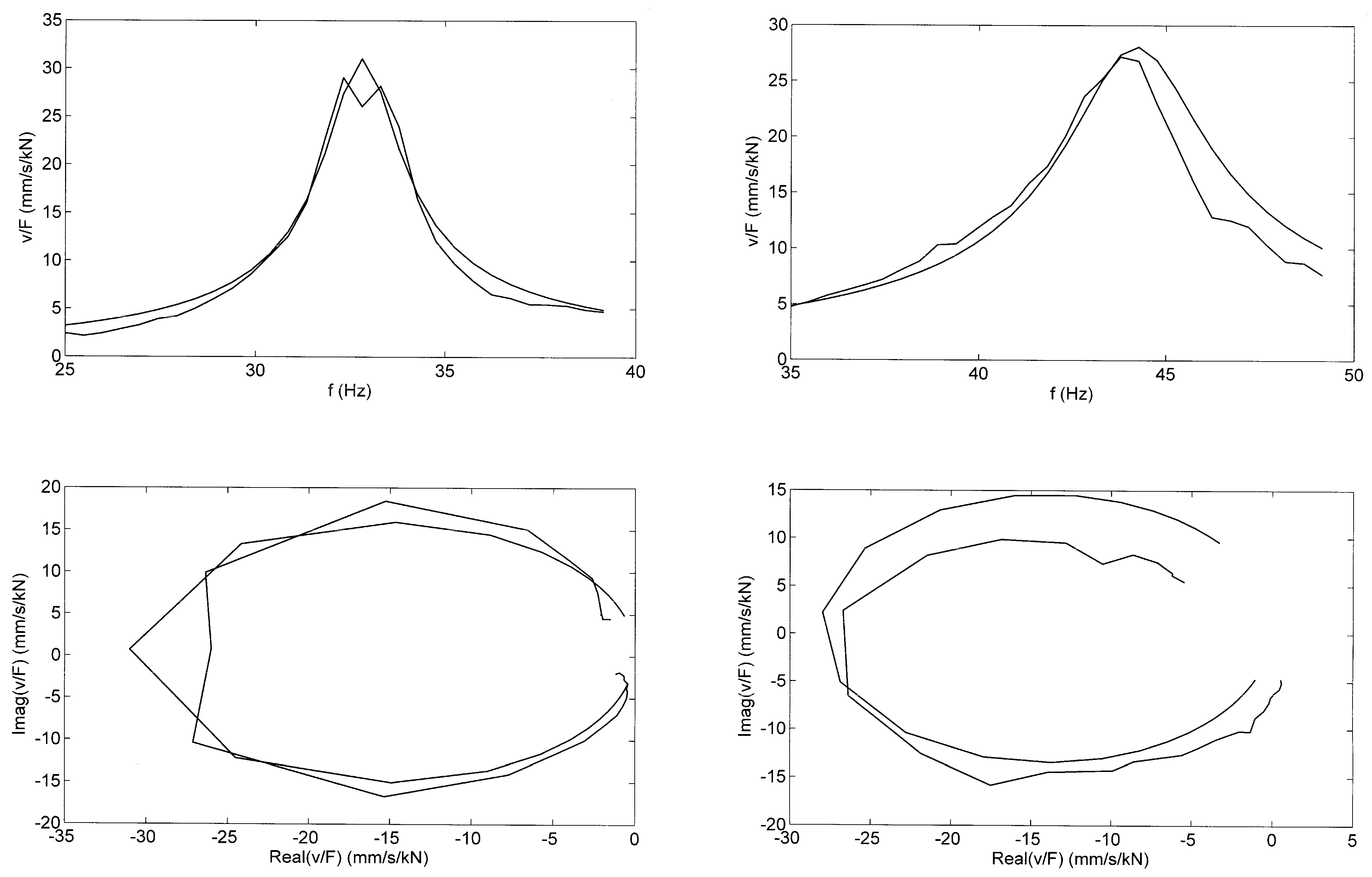

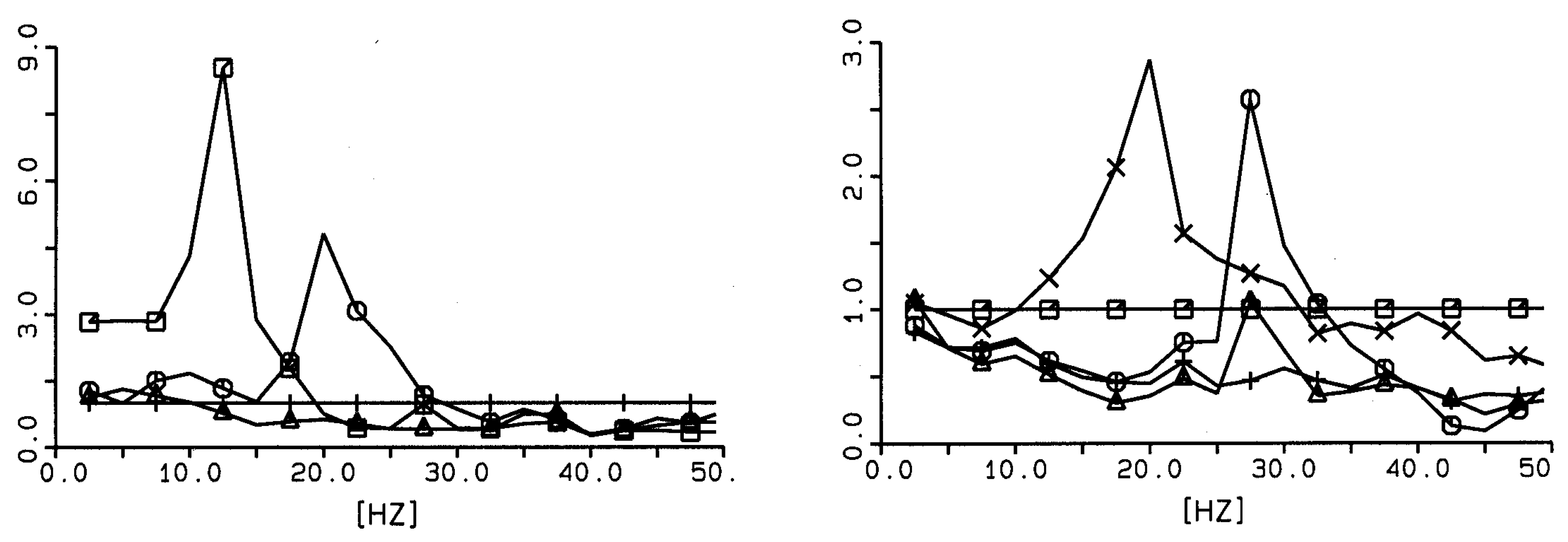
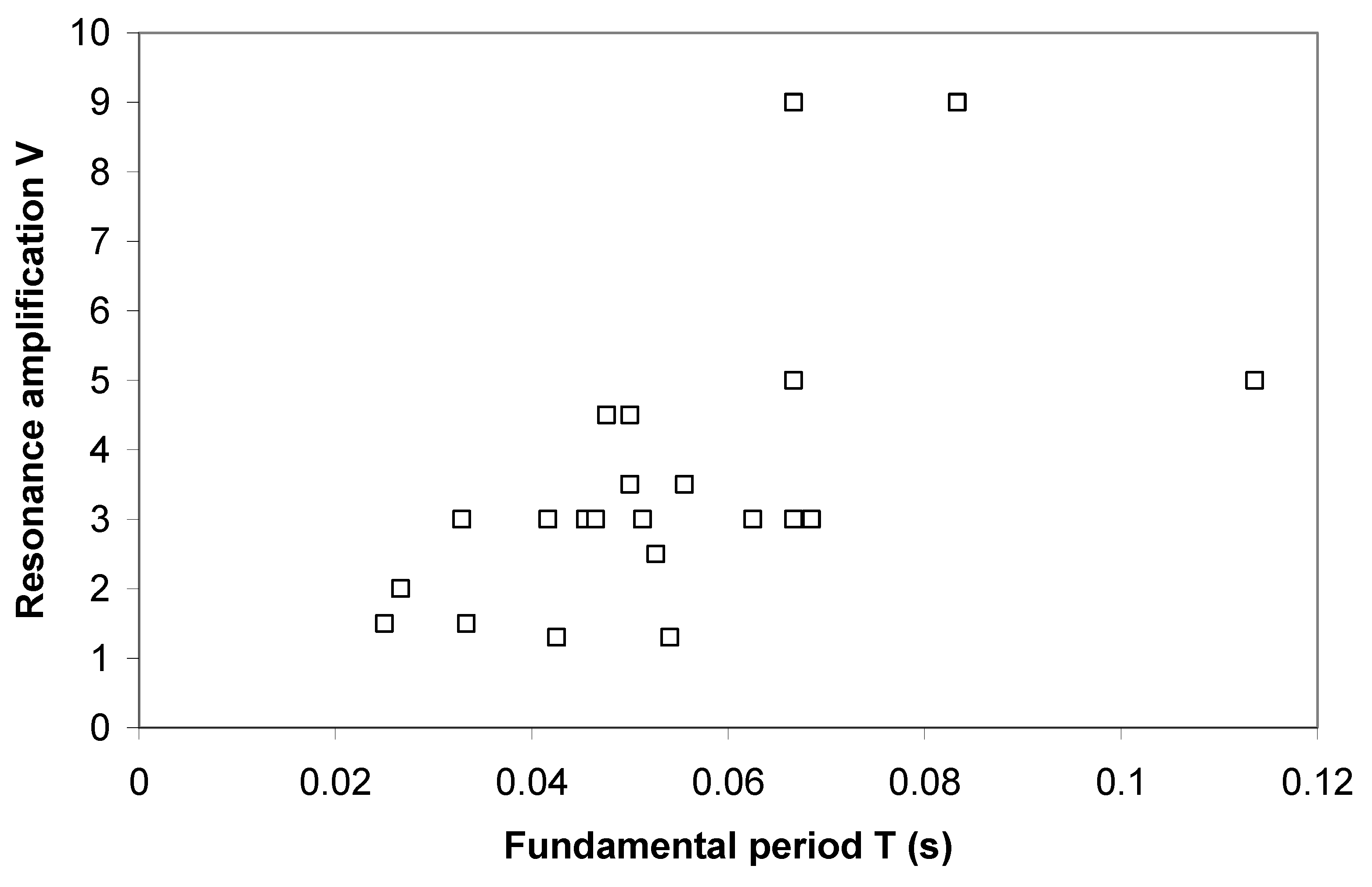

Disclaimer/Publisher’s Note: The statements, opinions and data contained in all publications are solely those of the individual author(s) and contributor(s) and not of MDPI and/or the editor(s). MDPI and/or the editor(s) disclaim responsibility for any injury to people or property resulting from any ideas, methods, instructions or products referred to in the content. |
© 2025 by the author. Licensee MDPI, Basel, Switzerland. This article is an open access article distributed under the terms and conditions of the Creative Commons Attribution (CC BY) license (https://creativecommons.org/licenses/by/4.0/).
Share and Cite
Auersch, L. Soil–Structure Interaction and Damping by the Soil—Effects of Foundation Groups, Foundation Flexibility, Soil Stiffness and Layers. Vibration 2025, 8, 5. https://doi.org/10.3390/vibration8010005
Auersch L. Soil–Structure Interaction and Damping by the Soil—Effects of Foundation Groups, Foundation Flexibility, Soil Stiffness and Layers. Vibration. 2025; 8(1):5. https://doi.org/10.3390/vibration8010005
Chicago/Turabian StyleAuersch, Lutz. 2025. "Soil–Structure Interaction and Damping by the Soil—Effects of Foundation Groups, Foundation Flexibility, Soil Stiffness and Layers" Vibration 8, no. 1: 5. https://doi.org/10.3390/vibration8010005
APA StyleAuersch, L. (2025). Soil–Structure Interaction and Damping by the Soil—Effects of Foundation Groups, Foundation Flexibility, Soil Stiffness and Layers. Vibration, 8(1), 5. https://doi.org/10.3390/vibration8010005




